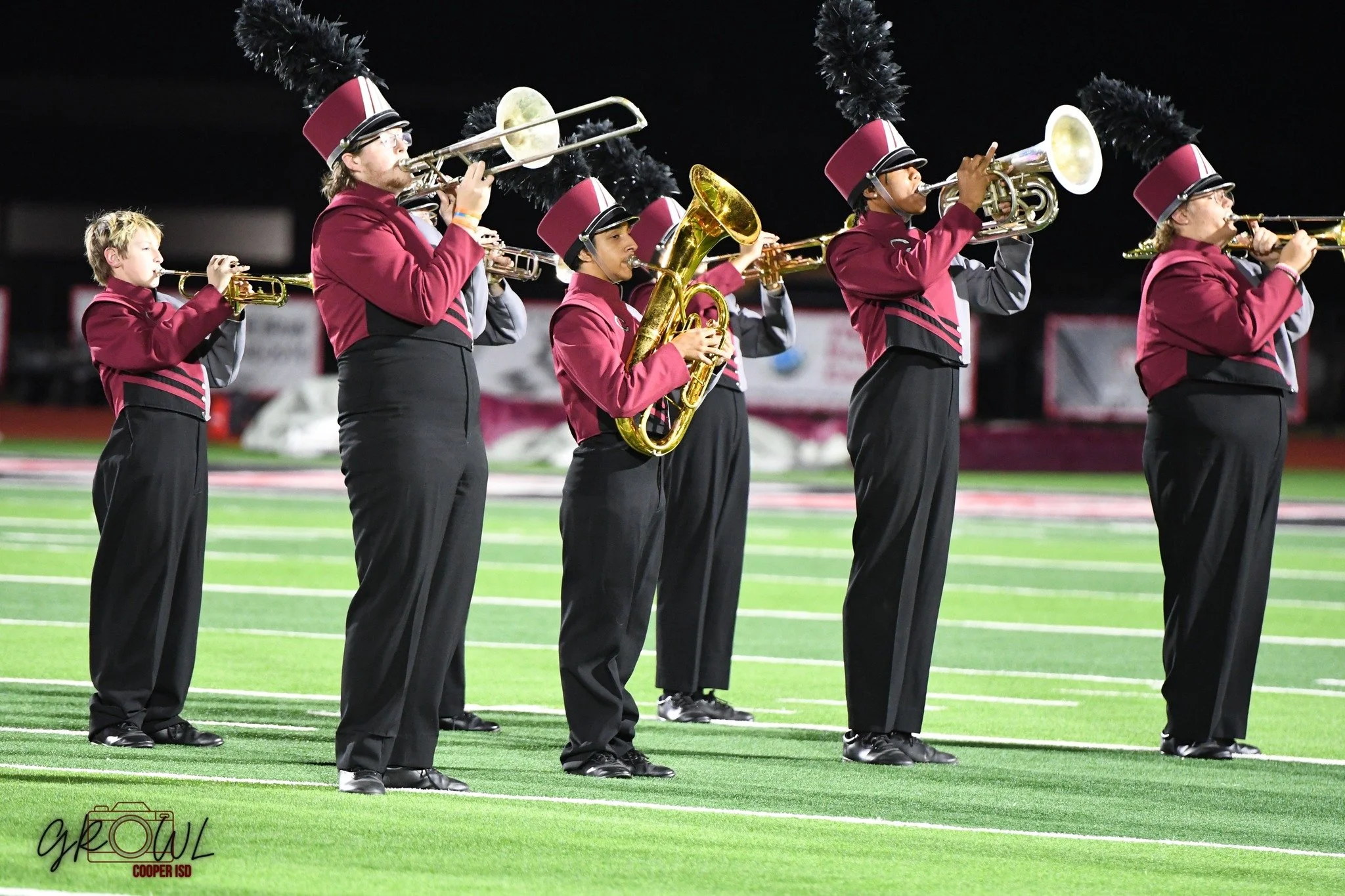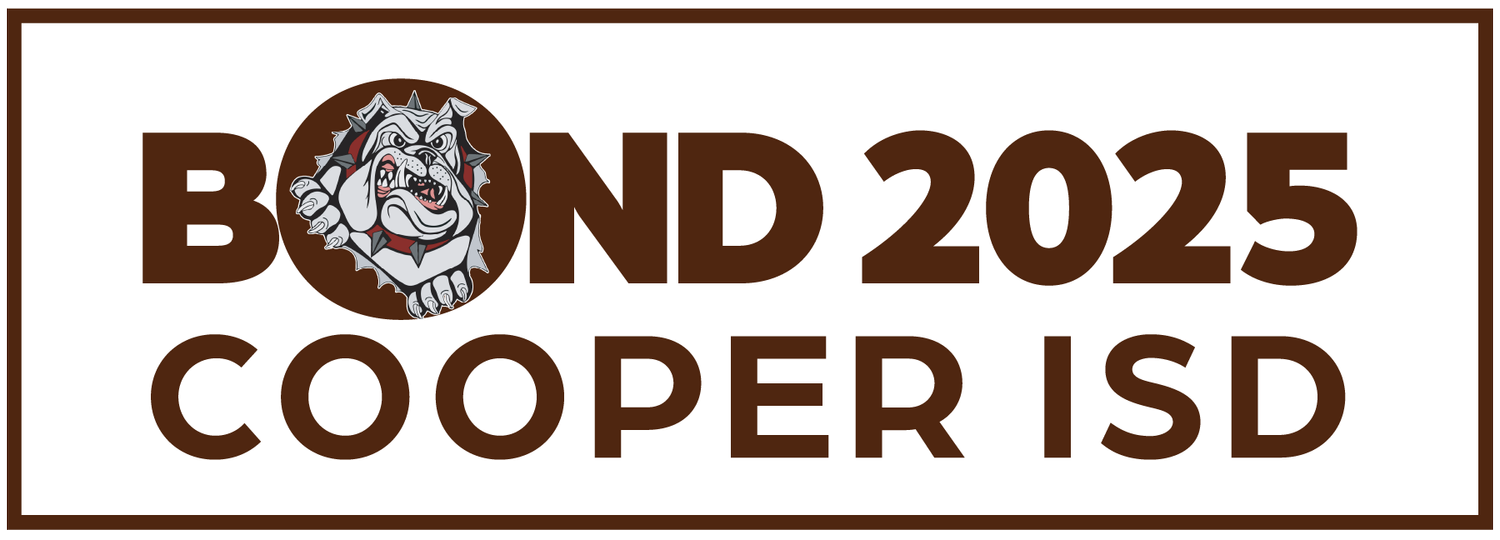
FAQ
Questions from the community
-
Cooper ISD has utilized Maintenance and Operations (M&O) funds for capital improvement projects including: new facilities for CTE and Science, new instructional addition to Elementary, Safety and Security upgrades, technology upgrades, new bus/van purchases, roof/turf replacement, and acquisition of land near elementary for the future site of daycare and traffic flow. The proposed bond package would provide funding to address additional projects using financing outside of the M&O budget.
-
Fund Balance is essentially a district’s savings account which serves to support repairs to facilities and/or fund the building of capital improvement projects, such as our elementary addition. The state does require a portion of the fund balance be set in reserve in case of an emergency.
Required for compliance: The TEA's Financial Integrity Rating System of Texas (FIRST) includes indicators related to a district's fund balance to ensure adequate funds for operations. Cooper ISD has received an “A” financial rating from FIRST for “Superior” management of school funds. -
When a district has a surplus of funds, it is deposited each year into fund balance to be utilized as a financial cushion for unexpected expenses, such as natural disaster recovery, new equipment purchases or capital improvements across the district.
-
CISD and the Board of Trustees have consistently preserved Maintenance and Operations (M&O) funds at the end of each fiscal year. These surplus funds have been added to the district’s fund balance, creating a reserve used to support a range of capital improvements.
Since 2020 the district has utilized over $13.5 M in fund balance to complete over 13 capital improvement projects, including new science additions, a greenhouse, a renovated central office and childcare center, an agricultural pavilion, and an elementary school expansion.
Additional projects include land purchases for future traffic flow, district-wide safety upgrades, infrastructure maintenance such as roof replacements, athletic field repairs, and the purchase of buses and vans. All projects have been funded through savings without requiring bonds or tax increases. -
No, if the district chose pre-design renderings, additional architect fees would be spent without knowing whether or not the projects would take place.
-
Band will use the Multi-Purpose Center for indoor rehearsals, seasonal practices, and full-ensemble performances.
Fine Arts will use the Multi-Purpose Center to show artwork and hold performances. Other uses include space for creative projects and events.
Sports Medicine will use the Multi-Purpose Center for injury prevention training, demonstrations, and on-site care during athletic events.
Color Guard will use the Multi-Purpose Center to practice indoors with storage space for flags and props.
STEM will use the Multi-Purpose Center as a controlled, competition-ready environment where students can practice drone flight and robotics, refine technical skills, and earn industry certifications.
Athletics will use the Multi-Purpose Center for team practices, training, and indoor games. Other uses include pep rallies, tournaments, and allow workouts to continue during inclement weather.
Other uses for the Multi-Purpose Center include a locker room, weight room, storage, CTE classrooms, Special Olympics, field day, community events, and various elementary activities.
-
The bond includes two propositions, each of which will be voted on separately. Learn more about projects included in the Cooper ISD bond by clicking here.
-
The additional proposed locker room and weight room allow multiple teams to train at the same time. The current fieldhouse utilizes a single shared weight room and locker areas for both boys and girls, limiting scheduling and space.
-
The last two bond elections were in 1997 and 2010. The 1997 bond has been fully paid off. The 2010 bond has two parts: one (a QSCB) will be paid off in February 2026, and the other, from a later refinancing, will be paid off in 2030.
-
If the bond is approved, each project will begin with a 4-6 month design and planning phase, followed by approximately 12 months of construction. On average, you can expect each project to take about 16-18 months from start to finish.
-
When we consider calling for a bond, we bring in financial advisors who review our current debt, and property values and based upon that determine the bond capacity. They tell us here is what you can borrow and pay back based upon what tax base you do have. Bonds are structured so that annual debt service payments align with projected tax revenues. If additional properties are added to the tax rolls or if property values increase, these changes can enhance the ability to repay debt more efficiently.
General
-
School districts are required by state law to ask voters for permission to sell bonds to investors in order to raise the capital dollars required to renovate existing buildings or build a new school. Essentially, it’s permission to take out a loan to build, renovate and pay that loan back over an extended period of time, much like a family takes out a mortgage loan for their home. A school board calls a bond election so voters can decide whether or not they want to pay for proposed facility projects.
-
Recent research by the Environmental Protection Agency suggests that a school’s physical environment can play a major role in academic performance. Leaky roofs and problems with heating, ventilation and air conditioning systems can trigger a host of health problems – including asthma and allergies – that increase absenteeism and reduce academic performance. Research links key environmental factors to health outcomes and students’ ability to perform.
-
Working with the Board of Trustees, teachers, and administrators from across the district, the facilities planning committee developed a list of items to consider for inclusion in a bond package. The District has been evaluating current facilities and equipment, ongoing enrollment, growth, and other district priorities with the Board of Trustees.
-
Under state law, bond funds must be used for items listed on the election ballot. In addition, if the bond passes, the district will invite community members to join a Bond Oversight Committee. This committee will meet regularly to oversee the construction of the bond projects.
-
The school district itself does not set property values. Property values are determined by the Delta County Appraisal District, an independent government agency responsible for estimating the market value of properties in the county each year.
The Appraisal District looks at things like:
Recent sales of similar homes in your area
Market trends (supply and demand)
Improvements or changes made to your property
Overall neighborhood growth and development
In short: The school district doesn’t control your home’s value—the real estate market and the county appraisal process do. Find out more information here.
-
No, bond funds cannot be used for teacher salaries.
Taxes
-
A school district’s tax rate is comprised of two components: the Maintenance & Operations tax (M&O) and the Interest & Sinking tax (I&S). The M&O rate is used to operate the school district including salaries, utilities, furniture, supplies, food, gas, etc. The I&S rate is used to pay off school construction bonds. Bond sales only affect the I&S rate.
-
If you qualify for an age 65+ or disabled person residence homestead exemption, the tax ceiling is the amount you pay in the year you qualified for your exemption. The school district taxes on your residence homestead may go below, but not above the ceiling amount. You must apply for this exemption.
You can apply for the homestead exemption here.
-
Texas legislature passed laws in 2019 requiring all school bond elections to include the following language on the ballot: “THIS IS A PROPERTY TAX INCREASE”. The state mandates all bond ballots to include this language, regardless of what individual exemptions each voter may have.
-
You can apply for the homestead exemption here.
-
If both propositions pass, there will be a $0.2595 I&S tax impact. For a home worth $171,894 that would be an impact of $6.90 a month.


